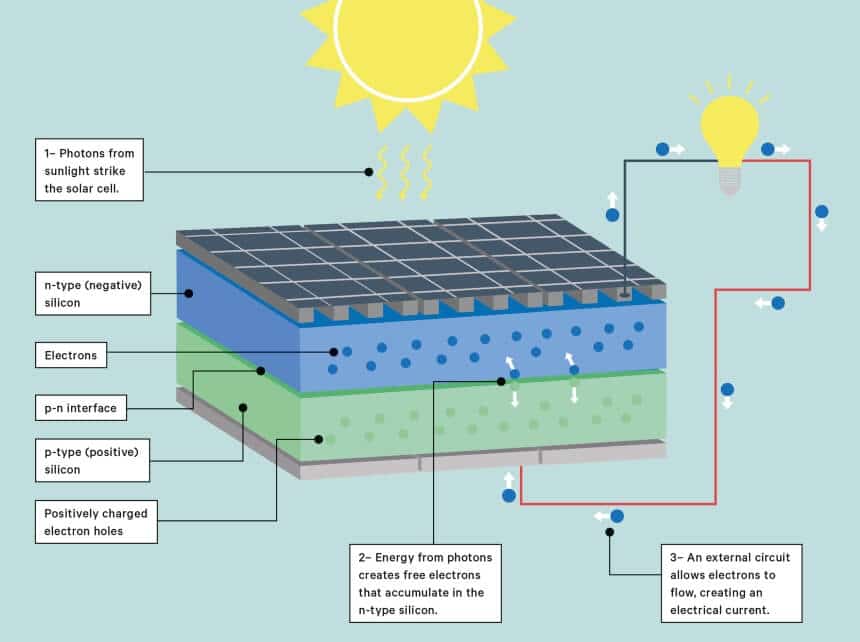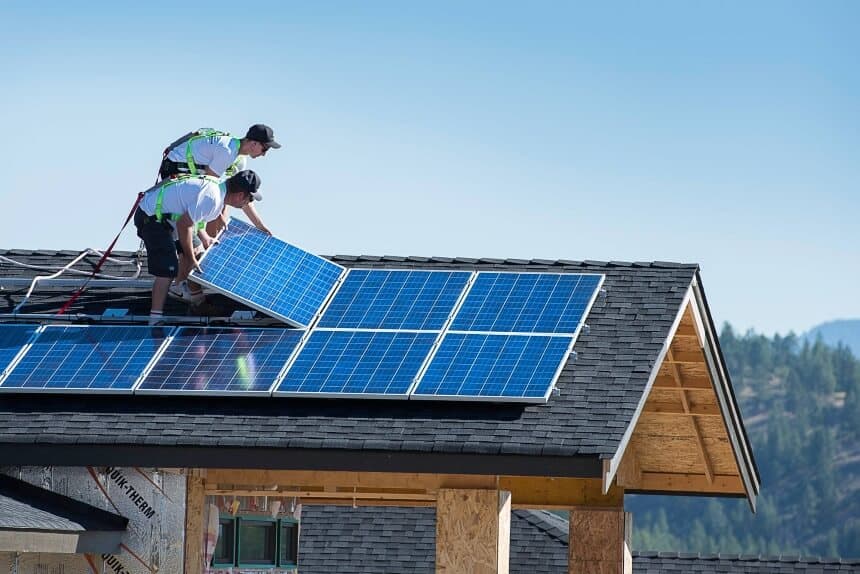The greatest potential source of sustainable energy has traditionally been the sun.
However, solar panels only presently convert less than 20% of the sun’s energy into power, despite advancements in technology.
The current record-high efficiency is approximately 33.3 percent.
One Reliable Source Turns One-Third of Solar Energy Into Electricity 33.3 percent Fraunhofer ISE’s silicon-based multi-junction solar cell A novel silicon-based multi-junction solar cell has been created by researchers at the Fraunhofer ISE in collaboration with the business EV Group (EVG).
This solar cell can convert precisely one-third of the incident sunlight into usable power.
Why should you be concerned about how to determine the efficiency of solar panels? First off, greater efficiency results in increased energy density, which allows you to install fewer panels and save money on installation.
More significantly, understanding about the efficiency of solar panels will enable you to know what you can do to make sure that they continue to function at their best.
If you have to choose between high-efficiency solar panels and generators, high-efficiency solar panels may be more useful.
This straightforward instruction will demonstrate the no-fuss approach to determining optimal and useful efficiency.
How Do Solar Cells Function?
When photons, or little units of light, strike atoms in a photovoltaic cell, they liberate the electrons, which is how solar panels produce energy.
Since energy is just electrons in motion, numerous photocells together can generate enough current and voltage to power your house.
The silicon semiconductors that make up a photovoltaic or solar cell are the same ones that power the majority of today’s devices.
Due to the addition of a small amount of phosphorus, a process known as doping, the top layer of the cell has more electrons, while the bottom layer has less electrons as a result of the addition of boron.
When light energy reaches the cell, the electric field created by their different charges leads electrons to flow.
These electrons are gathered from each cell by metal strips that constitute the circuitry that transmits solar energy.
It may surprise you to find that solar panels aren’t always composed of glass.
These days, solar panels that are flexible and even wearable may be used in construction materials, automobiles, and other things.

What Is the Efficiency of Solar Panels?
The amount of solar energy that is transformed into electricity by the photovoltaic cells in the solar panel is known as the solar panel efficiency.
Of course, depending on a variety of conditions, its efficiency fluctuates substantially.
Due to this, it is difficult to compare solar panels and determine how well they convert solar energy into electricity.
Solar panels are evaluated under typical settings known as Standard Test Conditions, or STCs, to make efficiency measurements simpler.
These criteria are contemporary industry standards that have been agreed upon by producers and different institutions, and they are as follows:
- 250C for the cell temperature (77F)
- 1000W/m2 solar irradiance
- Air mass – 1.5
We may then evaluate the efficiency of each solar panel after testing them all under similar circumstances.
For instance, a panel rated at 22% efficiency would convert 4% more sunlight into electricity than a panel rated at 18%.
How Is Solar Panel Output Efficiency Calculated?
The manufacturer’s specs typically make it easy to find the solar panel’s maximum efficiency.
This value, nevertheless, will be optimal when evaluated under STC circumstances.
You won’t be able to utilize it much unless your module performs similarly to STC.
The amount of electricity your solar panels are generating may then be determined by calculating your practical or real-world efficiency.
Here is a step-by-step approach that explains how to determine the output of a solar panel’s efficiency.
Step 1: Determine The Device’s Maximum Power Capacity And Size

The datasheet from the manufacturer will typically have this information.
Choose the panel’s nameplate rating/maximum capacity, Pmax temperature coefficient, and surface area in square meters.
The back of the solar panels also have this information.
If the surface area isn’t specified explicitly, you may figure it out by multiplying the panel’s length by its width.
For instance, standard solar panel dimensions are 65″ by 39″, or 1.651m × 0.9906m, resulting in a 1.6355m2 surface area.
Step 2: Split The Maximum Output Of The Solar Panel By Its Surface Area.
The next step is to determine the panel’s efficiency per unit area.
This will enable you to determine each solar cell’s efficiency, from which point you may determine a bank of solar panels’ overall output.
To achieve so, just divide the surface area by the maximum power rating (found on the nameplate or manufacturer’s datasheet).
Watts per square meter, or W/m2, will represent the outcome.
Step 3: Compare Real Values To STC Values.
The efficiency of the solar panel is tested by the manufacturer using conventional STC values, which are not applicable to real-world installations.
On the website of the National Renewable Energy Laboratory, you may discover information on the sun irradiance in your area in the US.
Grid Modernization | NREL | 2 Trusted Source Solar Resource Data and Tools To assist energy system designers, building architects and engineers, renewable energy analysts, and others in hastening the integration of solar technology on the grid, NREL offers data and tools on solar resource availability.
Information regarding temperature also varies.
The manufacturer bases the normal operating cell temperature (NOCT) on a moderate irradiation value of 800W/m2 at ambient temperatures of 200C.
To calculate the real efficiency loss at temperatures greater than 250C, they additionally provide a temperature coefficient of Pmax.
The panel loses a certain percentage of efficiency for each degree when the operating temperature exceeds NOCT.
Although some panel arrays already have one attached, you may also use a flat surface temperature sensor to measure this temperature.
Multiply the STC value by the Pmax coefficient after deducting the temperature difference.
For instance, if the temperature of the panel is 350C, multiply (35-25) x (Pmax).
As a consequence, you will get a negative figure, which you must then subtraction from the real efficiency value at the higher temperatures.
The operational efficiency would be 13.5 percent if you get 4.5 percent and your panel has an optimum efficiency of 18 percent.
Step 4: Determine The Effectiveness.
You may determine a solar panel’s efficiency using the formula below:
Solar panel efficiency = Unit Area (W/m2) / Solar irradiance value (W/m2)
Since the result is a ratio, you can easily multiply it by 100 to get the efficiency in terms of a percentage.
Use local irradiance values and, as mentioned in step #3, deduct the efficiency loss caused by high temperatures.
The working efficiency of the panel, which will assist you in determining the real energy production, is your ultimate solution.
The Renogy 12V portable solar panel suitcase is among the greatest 100W solar panels we have ever seen.
The foldable solar panel has a charge controller connected and a 21 percent efficiency rating, making it ideal for a mobile lifestyle.
Although some tweaking may be needed upon installation, users praised the model’s construction quality.
Factors Affecting a Solar Panel’s Efficiency
#1. The Amount Of Light That Your Panel Receives Weather And Climate
The weather varies from location to place at the same time.
Deserts and other areas with little to no cloud cover and direct sunshine have a significant advantage over areas with less daily sunlight.

#2. Temperature
The panel loses efficiency at a predetermined rate per degree Celsius above or below the nominal cell temperature (NOCT), which is known as the temperature coefficient of Pmax.
Pmax varies depending on the manufacturer of the solar panel.
#3. Panel Quality And Age Degradation Rate
Solar panels of greater grade are more efficient than those of lower quality.
Additionally, new panels are more efficient, losing just 0.8% of their efficiency annually.
Premium panels keep their high efficiency for a much longer period of time since they degrade at a lesser rate.
To assist you acquire the highest quality, we have put up an evaluation of the top solar panels.
#4. Inverter Efectiveness
The effectiveness of other parts like inverters and charge controllers also has an impact on how much electricity your solar panels produce.
Low energy loss between the solar panel output and the electrical energy brought into your house is ensured by high efficiency inverters.
#5. Additional Factors
Efficiency is impacted by the panel’s working circumstances, including shading, maintenance, and installation location.
For greatest incidence rate, solar panels should be angled at 450 degrees from the horizontal.
They are also located far from buildings and trees, which might have a negative impact on the amount of energy and intensity of incident sunlight that reaches the panels.
In general, there are many other factors to take into account before making a decision, even if solar panel efficiency is an essential one.
The Renogy 24V 600W Grid monocrystalline panels for house and cabin installation are one of the most suggested options.
The unit loses just 5% of its effectiveness over a 5-year period and can endure accumulation of snow, strong winds, and extreme heat.
Final Reflections
Every solar energy power plant’s success depends on the effectiveness of its solar panels.
Higher efficiency converts more free sunlight to useful power and reduces installation costs, whether it’s an RV package for living off the grid or a household unit.
Given that less than a fifth of incoming sunlight is routinely converted to power, we still have a long way to go in order to increase solar panel efficiency.
In a few years, technological advancements promise a 30% increase or more.
You can determine whether it’s time to update outdated panels by learning how to calculate the efficiency of solar panels.
There has never been a more exciting moment to take that step or make your first foray into sustainable energy than today.










